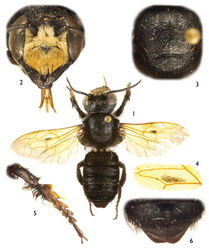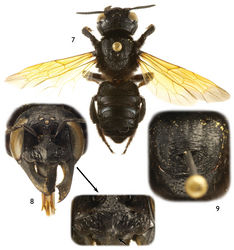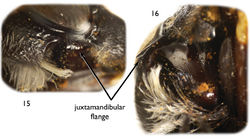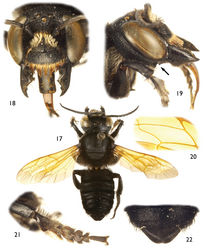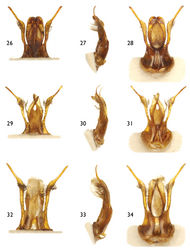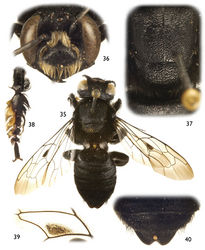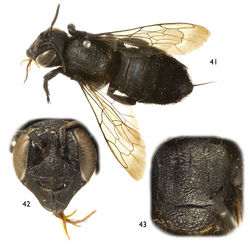Alocanthedon
| Notice: | This page is derived from the original publication listed below, whose author(s) should always be credited. Further contributors may edit and improve the content of this page and, consequently, need to be credited as well (see page history). Any assessment of factual correctness requires a careful review of the original article as well as of subsequent contributions.
If you are uncertain whether your planned contribution is correct or not, we suggest that you use the associated discussion page instead of editing the page directly. This page should be cited as follows (rationale):
Citation formats to copy and paste
BibTeX: @article{Engel2011ZooKeys101, RIS/ Endnote: TY - JOUR Wikipedia/ Citizendium: <ref name="Engel2011ZooKeys101">{{Citation See also the citation download page at the journal. |
Name
Alocanthedon Engel and Gonzalez subgen. n. – Wikispecies link – ZooBank link – Pensoft Profile
- Megachile aterrima Smith 1862[1]: 60.
- Chalicodoma aterrimum(Smith); Baker 1993[2]: 223.
- Megachile atratiformis Meade-Waldo 1914[3]: 456.
Type species
Chalicodoma (Alocanthedon) odontophorum Engel, sp. n.
Diagnosisn
Large (ca. 20–25 mm), black, parallel-sided megachilines resembling some large, black species of Callomegachile such as those of the Eumegachilana group (Figs. 1, 7, 10, 17, 23, 35, 41, 44) but in males with juxtamandibular flange or lamella and deep postgenal depression (Figs. 15, 16, 19); with oblique carina or lamella medially on disc of procoxa; with modified pro- (Figs. 5, 14, 21, 38) and mesotarsi; with dense cluster of short, black setae forming a conspicuous spot in the posterior half of the forewing medial cell (Figs. 4, 11, 39, except in Chalicodoma memecylonae); with five exposed metasomal sterna and with apical margin of sternum six typically exposed; with basally large gonocoxae (in comparison with those of the large species of Eumegachilana group where they are disproportionately small for the size of the bee) that are attenuate, divergent, upcurved at apices, greatly exceeding apices of penis valves, and without setae apically (Figs. 26–34); with penis valves slightly expanded apically; and in females with broad, not porrect, 4-toothed mandibles, with the outer surface dull, minutely roughened, and punctate; with clypeus slightly concave to V-shaped epistomal sulcus basally; with the pretarsal claws simple, basally with short, stout seta; and with the metasoma parallel-sided.
Description
Male: Mandible tridentate, with median inferior swelling or protuberance, basal projection absent; torulus with distinct lamella on upper half of inner margin; first flagellomere wider than long, length much less than one-half length of second flagellomere. Preoccipital carina distinct, continuing from vertex to gena; postgena bordering hypostoma with deep depression, posteriorly bordered by dense brush of black setae and long, finer patch of white setae, depression with bordering juxtamandibular flange or lamella near anterior mandibular base and bordering compound eye (Figs. 15, 16). Forewing with dense cluster of short, black, simple, lanceolate setae forming a conspicuous spot in posterior half of medial cell (Figs. 4, 11, 39: except in Chalicodoma memecylonae, Fig. 20). Pronotal lobe with strong carina; procoxa with apical, anteriorly-directed spine, with oblique carina or lamella medially on procoxal surface, anterior surface without rufescent bristles; protarsus greatly modified, flattened and expanded in species-specific forms, with variegated fringes; meso- and metafemora slightly swollen; mesotibial spur present; mesotarsi flattened with concave inner basal surfaces, posterior border variously modified; pretarsal claws symmetrical, cleft; mesobasitarsus weakly to strongly arched basally, with variously developed basal ventral concavity; metatarsi unmodified, slender; metasomal tergum VI with preapical carina gently concave medially (depth of concavity varies dramatically across species), without teeth; metasomal sternum V exposed, densely pubescent; apex of metasomal sternum VI normally exposed, densely pubescent; gonocoxae relatively large (by comparison with those of the large species of Eumegachilana group where they are disproportionately small for the size of the bee), attenuate, divergent, apices upcurved, greatly exceeding apices of penis valves, without setae apically (Figs. 26–34); volsella pointed, articulate, distinguished as separated sclerite; penis valves slightly expanded apically.
Female: Mandible broad, not porrect or elongate (similar to Callomegachile) except somewhat elongate in Chalicodoma odontophorum, 4-toothed (third tooth reduced in Chalicodoma aterrimum), without cutting edge, outer surface dull, minutely roughened and coarsely and shallowly punctate. Clypeus not protuberant, not covering labral base; first flagellomere wider than long, about one-half length of second flagellomere. Pretarsal claws simple, symmetrical, basally with short, stout seta. Metasoma parallel-sided; tergum VI very weakly concave in profile, with pubescence as on preceding terga; sternum VI with scopal setae as on preceding sterna, without bare rim; sterna without apical pubescent bands.
Etymology
The new genus-group name is a combination of the Greek words alokos (meaning, “furrow”) and anthedon (meaning, “bee”), and is a reference to the deep postgenal furrow universally in males of this lineage. The name is feminine.
Included species
In addition to the type species the subgenus includes the following taxa: Chalicodoma aterrimum (Smith 1862[1]), Chalicodoma atratiforme (Meade-Waldo, 1914), Chalicodoma memecylonae Engel sp. n., and Chalicodoma apoicola Engel sp. n. (Table 1).
Comments
The five currently included species are superficially quite similar, but for the hyaline or dark fuscous, rather than yellow, wings in Chalicodoma aterrimum and Chalicodoma apoicola, accordingly the new species are described in reference to the type species rather than repeat largely identical blocks of text. Owing the presence of species of Alocanthedon in the Philippines as well as across Wallace’s Line in Sulawesi it is likely that as of yet unrecognized taxa for the subgenus may occur in places throughout Indonesia and Malaysian Borneo, and perhaps as far East as Irian Jaya. Additional collecting of bees, for all groups, is needed across all of these islands.
Taxon Treatment
- Engel, M; Gonzalez, V; 2011: Alocanthedon, a new subgenus of Chalicodoma from Southeast Asia (Hymenoptera, Megachilidae) ZooKeys, 101: 51-80. doi
Other References
- ↑ 1.0 1.1 Smith F (1862) Catalogue of hymenopterous insects collected by Mr. A.R. Wallace in the islands of Ceram, Celebes, Ternate, and Gilolo. Journal of the Proceedings of the Linnean Society 6(22): 49–66. [Note: This section, from 1 March 1862, is the closing half of an article initiated in the previous number of the journal from 1 November 1861, 6(21): 36–48.]
- ↑ Baker D (1993) The type material of the nominal species of exotic bees described by Frederick Smith. Ph.D. Dissertation, Oxford University, Oxford, vi+312 pp.
- ↑ Meade-Waldo G (1914) Notes on the Hymenoptera in the collection of the British Museum, with descriptions of new species. Annals and Magazine of Natural History, Series 8, 14:450-464.
Images
|
